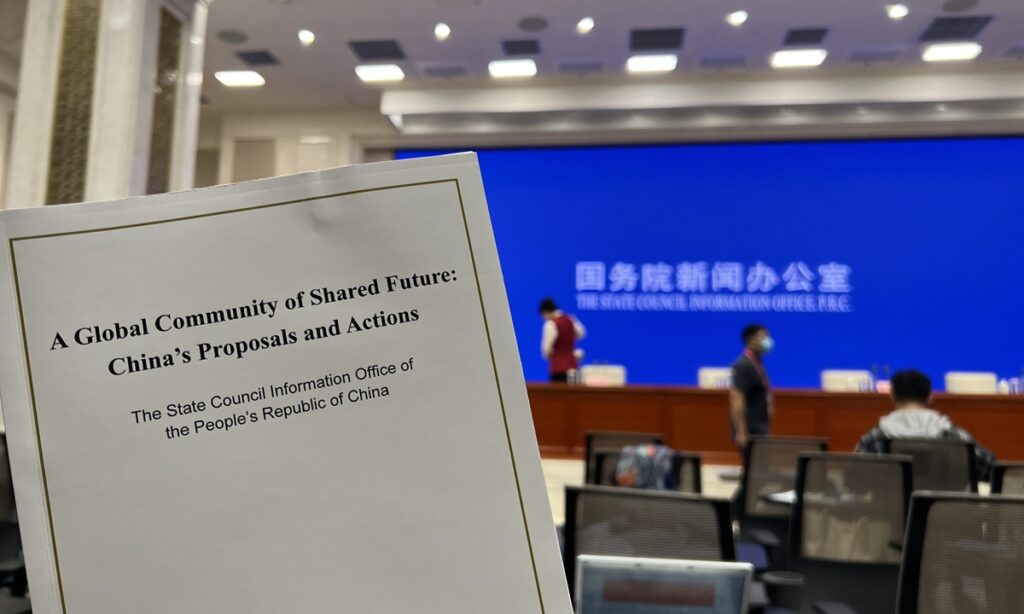The Chinese government released a white paper on Tuesday to introduce the theoretical base, practice and development of a global community of shared future, as by presenting China’s vision of the course of human development, it counters the hegemonic thinking of certain countries that seek supremacy.
The white paper, titled “A Global Community of Shared Future: China’s Proposals and Actions,” introduced the background for China to raise the concept of a global community of shared future as the world is undergoing changes on a scale unseen in a century with various problems posing unprecedented challenges for human society. The zero-sum game is doomed to fail, the white paper said. But certain countries still cling to this mindset, blindly pursuing absolute security and monopolistic advantages, which will do nothing for their development in the long run but create a major threat to the world.
It is increasingly obvious that the obsession with superior strength, and the zero-sum mentality are in conflict with the needs of our times, the white paper said, pointing out that the new era calls for new ideas.
To build a global community of shared future is to pursue openness, inclusiveness, mutual benefit, equity and justice, the white paper said. The goal is not to replace one system or civilization with another. Instead, it is about countries with different social systems, ideologies, histories, shared rights, and shared responsibilities in global affairs.
The vision of a global community of shared future stands on the right side of history and on the side of human progress. It introduces a new approach for international relations, provides new ideas for global governance, opens up new prospects for international exchanges and draws a new blueprint for a better world, according to the white paper.
Such important vision transcends outdated mindsets such as zero-sum game, power politics, and Cold War confrontations. It has become the overall goal of China’s major-country diplomacy in the new era, and a great banner that leads the trend of the times and the direction of human progress.
The concept of a global community of shared future has deep roots in China’s profound cultural heritage and its unique experience of modernization. It carries forward the diplomatic traditions of China and draws on the outstanding achievements of all other civilizations, the white paper said. It also manifests China’s time-honored historical traditions, distinct characteristics of the times, and a wealth of humanistic values.
The white paper also pointed out the direction and plan to build a global community of shared future including pressing ahead with a new type of economic globalization in which countries need to pursue a policy of openness and explicitly oppose protectionism, the erection of fences and barriers, unilateral sanctions, and maximum-pressure tactics, so as to connect economies and jointly build an open world economy.
Some countries are seeking to decouple from China, enclosing themselves in “small yards, high fences,” which will ultimately only backfire, the white paper said. Also, some people overstate the need to “reduce dependence” and “de-risk,” which is essentially creating new risks.
The direction and the plan also include following a peaceful development plan, fostering a new type of international relations, practicing true multilateralism and promoting the common values of humanity.
Over the past decade, China has contributed its strength to building a global community of shared future with firm conviction and solid actions.
For instance, by July 2023, more than three-quarters of countries in the world and over 30 international organizations had signed agreements on Belt and Road cooperation with China. The BRI originated in China but the opportunities and achievements it creates belong to the whole world. It’s an initiative for economic cooperation, not for geopolitical or military alliances, and it’s open and inclusive process that neither targets nor excludes any party, the white paper said.
Among those BRI projects, for example, the China-Laos Railway began operation on December 3, 2021, with 167 tunnels and 301 bridges built in 11 years along its total length of 1,035 kilometers. The railway construction created more than 110,000 local jobs, and helped build about 2,000 kilometers of roads and canals for villages along the railway, benefiting local people.
Besides the BRI, the Global Development Initiative, the Global Security Initiative and Global Civilization Initiative have evolved into a crucial cornerstone for building a global community of shared future, offering China’s solutions to major challenges pertaining to peace and development for humanity.
Facing constant flare-ups of hotspot issues, China has been committed to fulfilling its role as a responsible major country, pushing for the resolution of international and regional flashpoints, such as the Korean Peninsula, Palestine, the Iranian nuclear issue, Syria and Afghanistan, the white paper said.
On the Ukraine issue, China has actively promoted talks for peace, put forth four points, four things that the international community should do together and three observations, and released China’s position on the political settlement of the Ukraine crisis and has dispatched the special representative of the Chinese government on Eurasian affairs to engage in extensive interactions and exchanges with stakeholders on the political settlement of the Ukraine crisis.
Also, through the mediation of China, Saudi Arabia and Iran achieve historic reconciliation earlier this year, setting a fine example for countries in the region to resolve disputes and differences and achieve good neighborly relations through dialogue and consultation, and catalyzing a wave of reconciliation in the Middle East.
China has also proposed a range of regional and bilateral initiatives on building communities of shared future and working with stakeholders to build consensus and expand cooperation, there by playing a constructive role in promoting regional peace and development. It also boosts international cooperation in fields including fighting the COVID-19 pandemic, addressing disorder in cyberspace governance and dealing with the global climate challenge.
Over the past decade, the vision of a global community of shared future has gained broader support. More countries and people have come to the understanding that this vision serves the common interests of humanity, represents popular calls for peace, justice and progress, and can create the greatest synergy among all nations for building a better world, the white paper said.
(Global Times)




